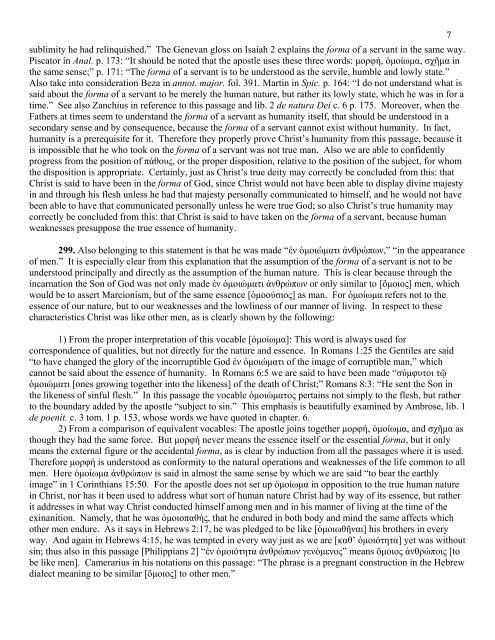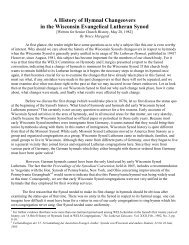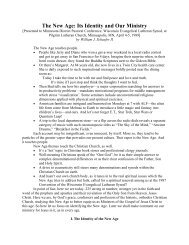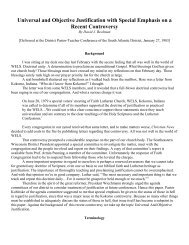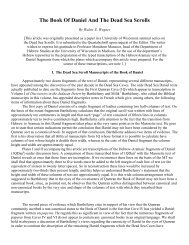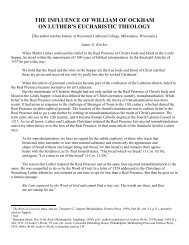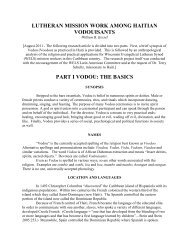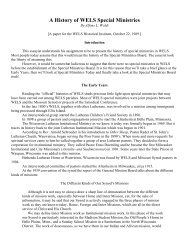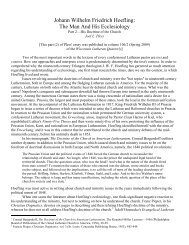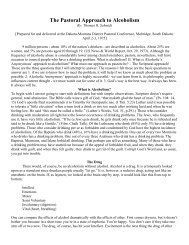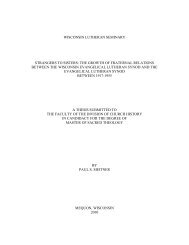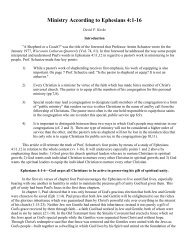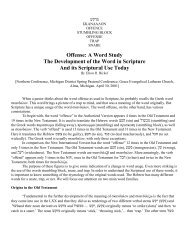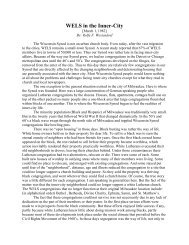Loci Theologici Loci Theologici
Loci Theologici Loci Theologici
Loci Theologici Loci Theologici
You also want an ePaper? Increase the reach of your titles
YUMPU automatically turns print PDFs into web optimized ePapers that Google loves.
7<br />
sublimity he had relinquished.” The Genevan gloss on Isaiah 2 explains the forma of a servant in the same way.<br />
Piscator in Anal. p. 173: “It should be noted that the apostle uses these three words: μορφή, ὁμοίωμα, σχῆμα in<br />
the same sense;” p. 171: “The forma of a servant is to be understood as the servile, humble and lowly state.”<br />
Also take into consideration Beza in annot. major. fol. 391. Martin in Spic. p. 164: “I do not understand what is<br />
said about the forma of a servant to be merely the human nature, but rather its lowly state, which he was in for a<br />
time.” See also Zanchius in reference to this passage and lib. 2 de natura Dei c. 6 p. 175. Moreover, when the<br />
Fathers at times seem to understand the forma of a servant as humanity itself, that should be understood in a<br />
secondary sense and by consequence, because the forma of a servant cannot exist without humanity. In fact,<br />
humanity is a prerequisite for it. Therefore they properly prove Christ’s humanity from this passage, because it<br />
is impossible that he who took on the forma of a servant was not true man. Also we are able to confidently<br />
progress from the position of πάθους, or the proper disposition, relative to the position of the subject, for whom<br />
the disposition is appropriate. Certainly, just as Christ’s true deity may correctly be concluded from this: that<br />
Christ is said to have been in the forma of God, since Christ would not have been able to display divine majesty<br />
in and through his flesh unless he had that majesty personally communicated to himself, and he would not have<br />
been able to have that communicated personally unless he were true God; so also Christ’s true humanity may<br />
correctly be concluded from this: that Christ is said to have taken on the forma of a servant, because human<br />
weaknesses presuppose the true essence of humanity.<br />
299. Also belonging to this statement is that he was made “ἐν ὁμοιώματι ἀνθρώπων,” “in the appearance<br />
of men.” It is especially clear from this explanation that the assumption of the forma of a servant is not to be<br />
understood principally and directly as the assumption of the human nature. This is clear because through the<br />
incarnation the Son of God was not only made ἐν ὁμοιώματι ἀνθρώπων or only similar to [ὅμοιος] men, which<br />
would be to assert Marcionism, but of the same essence [ὁμοούσιος] as man. For ὁμοίωμα refers not to the<br />
essence of our nature, but to our weaknesses and the lowliness of our manner of living. In respect to these<br />
characteristics Christ was like other men, as is clearly shown by the following:<br />
1) From the proper interpretation of this vocable [ὁμοίωμα]: This word is always used for<br />
correspondence of qualities, but not directly for the nature and essence. In Romans 1:25 the Gentiles are said<br />
“to have changed the glory of the incorruptible God ἐν ὁμοιώματι of the image of corruptible man,” which<br />
cannot be said about the essence of humanity. In Romans 6:5 we are said to have been made “σύμφυτοι τῷ<br />
ὁμοιώματι [ones growing together into the likeness] of the death of Christ;” Romans 8:3: “He sent the Son in<br />
the likeness of sinful flesh.” In this passage the vocable ὁμοιώματος pertains not simply to the flesh, but rather<br />
to the boundary added by the apostle “subject to sin.” This emphasis is beautifully examined by Ambrose, lib. 1<br />
de poenit. c. 3 tom. 1 p. 153, whose words we have quoted in chapter. 6.<br />
2) From a comparison of equivalent vocables: The apostle joins together μορφή, ὁμοίωμα, and σχῆμα as<br />
though they had the same force. But μορφή never means the essence itself or the essential forma, but it only<br />
means the external figure or the accidental forma, as is clear by induction from all the passages where it is used.<br />
Therefore μορφή is understood as conformity to the natural operations and weaknesses of the life common to all<br />
men. Here ὁμοίωμα ἀνθρώπων is said in almost the same sense by which we are said “to bear the earthly<br />
image” in 1 Corinthians 15:50. For the apostle does not set up ὁμοίωμα in opposition to the true human nature<br />
in Christ, nor has it been used to address what sort of human nature Christ had by way of its essence, but rather<br />
it addresses in what way Christ conducted himself among men and in his manner of living at the time of the<br />
exinanition. Namely, that he was ὁμοιοπαθής, that he endured in both body and mind the same affects which<br />
other men endure. As it says in Hebrews 2:17, he was pledged to be like [ὁμοιωθῆναι] his brothers in every<br />
way. And again in Hebrews 4:15, he was tempted in every way just as we are [καθ’ ὁμοιότητα] yet was without<br />
sin; thus also in this passage [Philippians 2] “ἐν ὁμοιότητα ἀνθρώπων γενόμενος” means ὅμοιος ἀνθρώποις [to<br />
be like men]. Camerarius in his notations on this passage: “The phrase is a pregnant construction in the Hebrew<br />
dialect meaning to be similar [ὅμοιος] to other men.”


